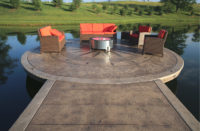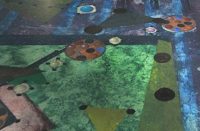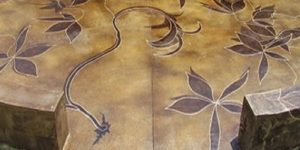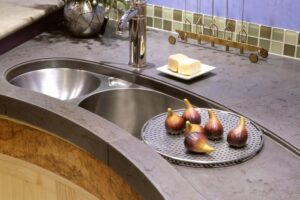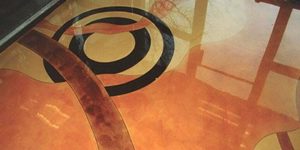Now that I’ve explained the Cartesian coordinates I can get into more elaborate design work. The theory of using the coordinates to plot points can be used anywhere in the room. It doesn’t only have to be about medallions. This is where I ask you to question what a medallion is to you. Is it just the center image in a room or can it expand into the space and be duplicated throughout?
I can use these points throughout the room. The space I’ve been using to film my articles is not big enough to show the true potential of this technique. Regardless, for this article, I brought back the basic designtile pattern as a background and then added scrollwork throughout the pattern.
Define scroll
In art, the scroll is an element of ornament and graphic design featuring spirals and rolling incomplete circle motifs, some of which resemble the edge-on view of a book or document in scroll form. Others are “plant” scrolls, which loosely represent plants, such as vines with leaves or flowers attached. Scrollwork is a term for some forms of decoration dominated by spiraling scrolls, today used in popular language for two-dimensional decorative flourishes and arabesques of all kinds, especially those with circular or spiraling shapes.
Scrollwork in its strictest meaning is rather different. The scroll is imagined as the curling end of a strip or sheet of some flat and wide material. It develops from strapwork, as the ends of otherwise flat elements, loosely imitating leather, metal sheets or broad leaves rather than plant tendrils. Rather than the “profile” view displaying the spiral, the forms are often shown front on with the width of the strip seen. It began in the Renaissance, and became increasingly popular in Mannerist and Baroque ornament.
Scrollwork (in the popular definition) is most commonly associated with Baroque architecture, although it’s been used in almost every decorative application, including furniture, metalwork, porcelain and engraving. In Mannerism, strapwork forms often terminated in scrolls. Modern blacksmiths use scrolls in ornamental wrought-iron work gates and balustrades, and they have formed the basis of many wallpaper designs.
Enter the coordinates
Let’s dig into what I had to do to add scrollwork into my design. For this article, it involves a 3-foot tile pattern on a diagonal. Then I created my Cartesian coordinates by chalking a big X through my design. You can use the diagonal intersections to help chalk those lines.
I started to draw my first scroll and realized I needed another large X in the floor. I mentioned in the last article how I use the Cartesian coordinates to my advantage even if I don’t use them exactly by the book. This is one of those times.
The more you split up your symmetrical space, the easier it is to draw the design. The second X allows tighter symmetry. To draw the second X, I measured another point from the center point. For this design, I measured 2-feet out and up in all four directions and then chalked through those points. We did the same thing to find the diagonal lines of the compass rose in the first medallion article. (See photo above.)
I drew my first scroll between the perpendicular and diagonal coordinate lines. Then I mimicked it by plotting its points to finish off the first quadrant. With a quarter of the design now done, I can decide if I need to change anything.
The plot thickens
From this point, it can be a plotting nightmare, but once you get the hang of plotting points it gets easier and it will go a lot faster than you expect. At the onset, though, it looks and sometimes feels like it takes forever.
Think about everything you need to do for a basic interior stain and seal job. You have so much time-consuming cleaning, grinding and prep work that must be done before you get to the fun part. But once you get there, everything goes relatively fast. This design feels the same. Once all the points are plotted the drawing takes seconds.
I have done designs like this so much that I can easily match the width I want throughout the design. To control the width of the scrollwork, I use the same technique as when I’m working on a border for a patio or a pool deck. A lot of those spaces have curved edges.
For this design, I did a 4.5-inch width. I just set my tape measure close to that width and plotted as many points as I needed to draw the second side of the scroll. I know it seems tedious but look at the results.
In my next article, I’ll discuss how you can use the tile pattern as part of your plotting technique.
Video Tutorial

